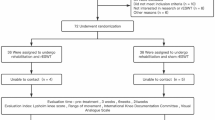Summary. The ACL in the rabbit is innervated by three types of nerve fibres. These subserve vasoconstriction, nociceptive and proprioceptive purposes. The aim of this paper was to investigate the revascularisation and reinnervation of cyropreserved ACL allografts in 22 New Zealand white rabbits. Cyropreserved grafts were used as they may excite less host immune response. Both microangiographic and immunohistochemical methods were used. We found that cryopreserved allografts exhibited little immune response, revascularisation was considerable by the 24th postoperative week and reinnervation was essentially complete by then. No mechanoreceptors were found in ACL allografts. In rabbits, the anatomical basis for the participation of ACL allografts in sensorimotor reflexes is not given before the twelfth week after transplantation.
Résumé. Nous avons examiné par méthodes micro-angiographiques et immuno-histo-chimiques la revascularisation et l’innervation d’un allogreffon cryopréservé (os – ligament croisé antérieur – os), chez 22 lapins de Nouvelle Zélande. Au sein de la greffe, existe une hypervascularisation maximale à 6 semaines, persistante à 12 semaines et se normalisant 24 semaines après la transplantation. Le panicule adipeux du genou était une source importante pour la revascularisation du greffon. L’immuno-histo-chimie a montré la présence de 3 types de fibres nerveuses au sein du ligament croisé: des afférents sensoriels mécano-réceptifs, des afférents sensoriels nociceptifs et des efférents sympathiques vaso-moteurs. Les contrôles ont montré l’existence de plusieurs fibres des 3 types de nerf; les terminaisons sensitives étaient toutes des corpuscules de Ruffini. Il n’y avait pas de fibre nerveuse au sein de l’allogreffe du ligament croiséà 3 et 6 semaines après la transplantation. Des fibres d’aspect cicatriciel étaient détectées à 12 semaines, tandis que des contrôles plus tardifs montraient un nombre et une distribution presque normale des filets nerveux. Aucun récepteur mécanique ne fut trouvé dans l’allogreffe. Chez le lapin, les bases anatomiques de la participation sensitivo-motrice de l’allogreffe du ligament croisé antérieur n’existent pas avant la 12ème semaine après la transplantation.
Similar content being viewed by others
Author information
Authors and Affiliations
Additional information
Accepted: 11 May 1995
Rights and permissions
About this article
Cite this article
Fromm, B., Schäfer, B., Parsch, D. et al. Reconstruction of the anterior cruciate ligament with a cyropreserved ACL allograft . International Orthopaedics SICOT 20, 378–382 (1997). https://doi.org/10.1007/s002640050102
Issue Date:
DOI: https://doi.org/10.1007/s002640050102




